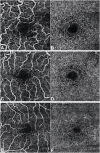Optical Coherence Tomography Angiography for the Evaluation of Retinal Vasculature in Fabry Disease: Our Experience and Review of Current Knowledge
- PMID: 33767663
- PMCID: PMC7985262
- DOI: 10.3389/fneur.2021.640719
Optical Coherence Tomography Angiography for the Evaluation of Retinal Vasculature in Fabry Disease: Our Experience and Review of Current Knowledge
Abstract
Purpose: Optical coherence tomography angiography (OCTA) is a non-invasive and objective tool for the evaluation of the retinal microvascular changes in Fabry disease (FD). We investigated changes in retinal vasculature in FD patients, and the possible correlation with systemic parameters, by using OCTA, and reviewed the current status of literature. Methods: Thirteen FD patients (eight females, five males, mean age 49.85 ± 14.7 years) were compared with 13 age- and sex-matched healthy controls. OCTA 3 × 3 mm macular scans were performed in all subjects. We evaluated the vessel density and vessel perfusion in distinct macular areas (whole, inner, and outer) of both the superficial capillary plexus (SCP VD and SCP VP) and of the deep capillary plexus (DCP VD and DCP VP). We also evaluated the foveal avascular zone (FAZ) metrics (area, perimeter, and circularity), and correlation between systemic and OCTA parameters. A literature review on the current understanding of OCTA in FD is then presented. Results: FD patients showed significantly lower SCP VD values in the whole area (17.37 ± 2.08 mm-1 vs. 18.54 ± 1.21 mm-1; p-value 0.022), as well as in the outer area (17.46 ± 2.10 mm-1 vs. 19.08 ± 1.14 mm-1; p-value 0.002), but not in the inner. Even the DCP VD was significantly lower in all the imaged areas: whole (17.75 ± 3.93 mm-1 vs. 19.71 ± 1.20 mm-1; p-value 0.024), outer (18.25 ± 4.17 mm-1 vs. 20.33 ± 1.20 mm-1; p-value 0.023), and inner (19.54 ± 4.17 mm-1 vs. 21.96 ± 1.55 mm-1; p-value 0.011). There were no significant differences in vessel perfusion parameters (both SCP VP and DCP VP ones) and FAZ. No significant correlations were found between the OCTA parameters and systemic parameters (maximal left ventricular wall thickness and glomerular filtration rate) in FD patients. Conclusions: OCTA can be considered as a promising non-invasive tool, which enables a quantitative evaluation of retinal vascular involvement in FD, despite the varying data reported in literature. Our results support the use of OCTA as an objective tool to evaluate retinal vascular abnormalities in FD. The utility of OCTA in FD needs to be validated by longitudinal studies taking into account the overall progression of the disease.
Keywords: Fabry disease; OCTA; optical coherenc tomography angiography; vascular density; vascular perfusion.
Copyright © 2021 Bacherini, Vicini, Nicolosi, Tanini, Lenzetti, Finocchio, Cirami, Dervishi, Rizzo, Virgili, Giansanti and Sodi.
Conflict of interest statement
The authors declare that the research was conducted in the absence of any commercial or financial relationships that could be construed as a potential conflict of interest.
Figures





Similar articles
-
Evaluating the Quantitative Foveal Avascular Zone and Retino-Choroidal Vessel Density Using Optical Coherence Tomography Angiography in a Healthy Indian Population.Cureus. 2022 Aug 4;14(8):e27669. doi: 10.7759/cureus.27669. eCollection 2022 Aug. Cureus. 2022. PMID: 36072178 Free PMC article.
-
Optical Coherence Tomography Angiography for the Evaluation of Retinal and Choroidal Vasculature in Retinitis Pigmentosa: A Monocentric Experience.Diagnostics (Basel). 2022 Apr 19;12(5):1020. doi: 10.3390/diagnostics12051020. Diagnostics (Basel). 2022. PMID: 35626176 Free PMC article.
-
[Correlation of capillary plexus with visual acuity in idiopathic macular epiretinal membrane eyes using optical coherence tomography angiography].Zhonghua Yan Ke Za Zhi. 2019 Oct 11;55(10):757-762. doi: 10.3760/cma.j.issn.0412-4081.2019.10.006. Zhonghua Yan Ke Za Zhi. 2019. PMID: 31607064 Chinese.
-
Retinal Microvascular Changes in Mild Cognitive Impairment and Alzheimer's Disease: A Systematic Review, Meta-Analysis, and Meta-Regression.Front Aging Neurosci. 2022 Apr 28;14:860759. doi: 10.3389/fnagi.2022.860759. eCollection 2022. Front Aging Neurosci. 2022. PMID: 35572135 Free PMC article.
-
Retinal and choroidal microvascular alterations in Behcet's disease without ocular manifestations: A systematic review and meta-analysis.Front Med (Lausanne). 2022 Jul 22;9:911990. doi: 10.3389/fmed.2022.911990. eCollection 2022. Front Med (Lausanne). 2022. PMID: 35935767 Free PMC article.
Cited by
-
Retinal biomarkers of Cerebral Small Vessel Disease: A systematic review.PLoS One. 2022 Apr 14;17(4):e0266974. doi: 10.1371/journal.pone.0266974. eCollection 2022. PLoS One. 2022. PMID: 35421194 Free PMC article.
-
Ophthalmic Manifestations in Fabry Disease: Updated Review.J Pers Med. 2023 May 27;13(6):904. doi: 10.3390/jpm13060904. J Pers Med. 2023. PMID: 37373893 Free PMC article. Review.
-
Correlation of retinal vascular characteristics with laboratory and ocular findings in Fabry disease: exploring ocular diagnostic biomarkers.Orphanet J Rare Dis. 2023 Oct 8;18(1):314. doi: 10.1186/s13023-023-02932-x. Orphanet J Rare Dis. 2023. PMID: 37807078 Free PMC article.
-
Investigation of OCTA Biomarkers in Fabry Disease: A Long Term Follow-Up of Macular Vessel Area Density and Foveal Avascular Zone Metrics.Ophthalmol Ther. 2023 Oct;12(5):2713-2727. doi: 10.1007/s40123-023-00776-z. Epub 2023 Aug 5. Ophthalmol Ther. 2023. PMID: 37542614 Free PMC article.
-
Ocular findings and their correlation with disease severity in Fabry disease in South-East Anatolia.Int Ophthalmol. 2023 Jul;43(7):2301-2306. doi: 10.1007/s10792-022-02626-6. Epub 2023 Jan 3. Int Ophthalmol. 2023. PMID: 36595126
References
LinkOut - more resources
Full Text Sources
Other Literature Sources
Miscellaneous

